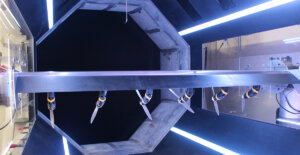
USC Viterbi Assistant Professor Mitul Luhar dives into the Pacific waves and observe his favorite topic: turbulence.
Porous cellular materials—materials which have repeating structures that self-tesselate to fill space—are ubiquitous in nature, from aquatic corals and sponges to plant tissue and bird feathers. The microstructure of such materials plays a big role in dictating their physical properties, such as high strength, low density and stiffness. For years, scientists have extrapolated this concept to develop materials that are strong, as well as lightweight. Now, researchers at USC Viterbi School of Engineering are looking at porous cellular materials for another purpose: to control fluid flow.
Mitul Luhar, assistant professor in the USC Viterbi Department of Aerospace and Mechanical Engineering was awarded $500K by the NSF CAREER program to develop scientific tools to help design cellular materials for flow control. Development of porous cellular materials has the potential to reduce “noise”—disruptions caused by turbulent fluctuation in pressure; decrease drag—a force that opposes forward motion that can be created by friction between the water and the surface of the vehicle flowing through it; and regulate heat transfer.
Said Luhar: “Since porous cellular materials allow fluid to pass through, we can, in principle, design the cell structure to regulate the fluid flow in clever ways. The project will broadly build upon this idea, with the goal of controlling fully turbulent flows. This could result in significant performance improvements for aircrafts, water vessels, and ground vehicles.”
Turbulence—characterized by chaotic changes in pressure and flow velocity—is an essential factor considered when designing airplanes, ship hulls, pipelines and more. The project builds on preliminary evidence that anisotropic porous materials—materials that let fluid pass through much more easily in one direction compared to the other two—have the potential to reduce fluid friction in turbulent flows.
Luhar’s research focuses primarily on gaining a better understanding of the turbulent flow over a porous surface so we can better predict the effect of such materials have on fluid flow. This understanding can lead to better designs and improve performance of water, air and ground vehicles, saving money, fuel and time in transit.
In preparation for this project, Luhar and Ph.D. students in the AME department, including Christoph Efstathiou, Andrew Chavarin, and Shilpa Vijay, have developed computational models to predict the effect of different types of porous materials on turbulent flows, designed and fabricated cellular materials to test, and conducted several proof-of-concept laboratory tests. The next step, Luhar says, is to increase the scope and depth of these efforts.
“We need to test and verify our computational models further and push the boundaries of what is manufacturable in terms of cellular materials. Once we have more confidence in both these areas, we will iterate on laboratory tests,” Luhar said.
The computational models Luhar has developed will help optimize properties such a porosity and permeability to reduce friction and suppress near-wall turbulence. These results will then be used to design and fabricate (via 3D-printing) cellular materials exhibiting specific properties identified by the models, bridging the gap between what’s theoretically possible and what can actually be created on a large scale.
Turbulent flow physics remains one of the more difficult to understand areas of study, but one that scientists agree could lead to great technological insights if better understood. The experiments Luhar and his students plan to complete will help measure and record the statistical and structural features of a turbulent flow, providing further insights into the study of turbulent flow physics overall. The end goal: creating a set of materials that can suppress turbulent-wall flow—a flow characterized by a smooth boundary, for example where water moves within a pipe—consistently and at a large scale.
The research grant also supports educational outreach, including several undergraduate research and senior design projects at USC and K-12 outreach efforts through an existing partnership at the STEM Academy of Hollywood—a local, inner city public school. For this program, Luhar will partner with the Principal of STEM Academy Paul Hirsch and Katie Mills, Co-director of the K-12 STEM Center at the USC Viterbi School of Engineering. The grant provides a paid externship for an engineering teacher from the STEM Academy to visit USC and shadow the ongoing research over the summer. In the fall, Luhar, who has been working with STEM Academy for the past three years, will present his research and underlying concepts of fluid dynamics at the school. In the spring, students would use these concepts for a wind tunnel design competition. The outreach is aimed at high school sophomores and juniors.
Recently, Luhar was announced as the inaugural Henry Salvatori Early Career Chair. This appointment recognizes Mitul’s exceptional distinction in aerospace and mechanical engineering.
Luhar joined the USC Viterbi Department of Aerospace and Mechanical Engineering as an Assistant Professor in 2015. Before joining USC, he was a postdoctoral scholar in the Graduate Aerospace Laboratories at Caltech. Mitul earned his Ph.D. from MIT in 2012, where he was awarded the Edward H. Linde Presidential Fellowship and the Martin Family Society Fellowship for Sustainability. He earned B.A. and M.Eng. degrees from the University of Cambridge in 2007.
The Faculty Early Career Development (CAREER) Program offers the National Science Foundation’s most prestigious awards in support of early-career faculty who have the potential to serve as academic role models in research and education and to lead advances in the mission of their department or organization.
Luhar’s work is funded by NSF CAREER Award #1943105: Flow Control with Cellular Materials.
Published on December 16th, 2019
Last updated on December 16th, 2019









